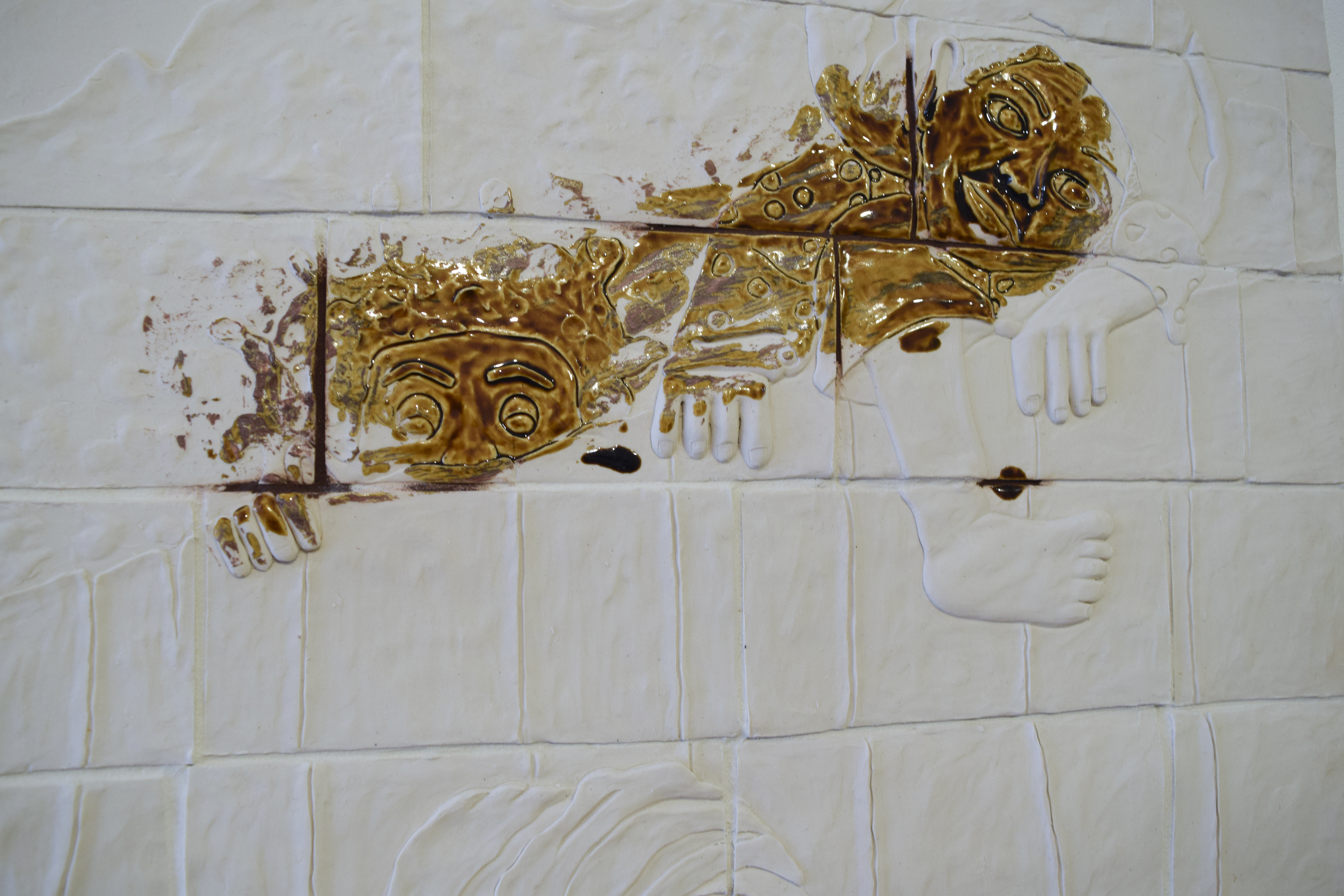Main Space Exhibition /

Chester Vincent Toye and their work "Still from Telsa Toucher (video), 2020
What’s the Value of a Dollar?
Matthew Kyba
May 27th, 2022 - July 9th, 2022
What’s the Value of a Dollar? invites 6 artists and collectives to examine how profit-driven entities have historically exploited and dominated societies, communities, and bodies. Using video, installation, photography, and painting, the exhibition enfolds complex matrices of racial politics, socio-economic (dis)parity, and political agency to argue that North American economies not only exist, but flourish through marginalizing their own consumers and workforce. Capitalist frameworks feed off of subjugated bodies to reinforce economically productive hierarchies of race, culture, gender, and affluence. The exhibition’s title questions how monetary capital is traded and valued against ethical, cultural, and physical sacrifice. Included works employ capitalistic visual language, which acts in protest against market-based economies. Research-based approaches are utilized to historically map capitalism’s reliance on the communities it targets and marginalizes. What is the Value of a Dollar? argues that there cannot be ethical consumption and production under capitalism, and offers ways to reclaim agency by co-opting corporate tactics and language historically used to disenfranchise.
Opening Reception /
The opening reception & artist talk for “What’s the value of a dollar?” May 27th, from 7 - 9 PM. Matt Kyba will be in conversation with Caleb Yohannes, from 7 to 8 PM, followed by a reception from 8 to 9 PM!
Opening Reception /
The opening reception & artist talk for “What’s the value of a dollar?” May 27th, from 7 - 9 PM. Matt Kyba will be in conversation with Caleb Yohannes, from 7 to 8 PM, followed by a reception from 8 to 9 PM!
Curatorial Statement /
The exhibition furthers Matthew Kyba’s curatorial interest in de-stabilizing entrenched political institutions through concentrated critique. Kyba’s previous curatorial interests have attempted to provide solutions or critical engagement to economic-based issues, beginning with his creation of Bunker 2 art space in Toronto, ON – a non-profit exhibition space out of a repurposed shipping container. The venue was a response to the hyper-inflation of real estate in the Toronto, migrating artists outside the city while pushing out valuable exhibition spaces for emerging artists. He is very interested in curating under-represented and marginalized voices to examine modes of oppression and ways to reclaim agency. His curatorial imperative mirrors the beginning attitudes of Artist-Run Centres; to nuance and provide space for important cultural discourse using research-based practices as springboards for educational and perspective growth.
Artists /
Each practice investigates how economies cannibalize their producers and consumers to reinforce systems of inequality in North America and beyond. These artists/historians trace how economic practices marginalize their own communities, with corresponding understanding that seemingly futile attempts at rectifying unbalanced relationships still yield the knowledge needed for larger societal change. Rather than provide hopeful but improbable solutions, these practices offer an initial step towards equalization: informed analyses for critical assessments that provide clearer, embodied understanding of how economies marginalize and subjugate their own people. Further, the concerns, conceptual motivations and formal strategies addressed in these individual works are brought into contact in productive ways, relaying new considerations and questions through their curatorial juxtaposition and interaction.
Curator Bio /
Matthew Kyba is a curator and independent researcher. He is currently the Curator of Exhibitions at The Ministry of Culture & Tourism in Ohio. Recent exhibitions have traveled across Canada to Museum London, The Art Gallery of Hamilton, The Winnipeg Art Gallery, and many artist run centers. Upcoming curatorial projects include projects at the Art Gallery of Alberta, The Foreman Art Gallery, and AceArtInc.

TJ Shin’s Universal Skin Salvation (2018), showcases a custom line of Korean cosmetics (K-beauty), that problematizes the fetishization of Korean skin, Asiatic femininity, and the act of carrying out corporeal damage for aesthetic beauty. Shin’s works involve the production and commercialization of “desire,” evolving out of the Korean War and continuing to dispossess Korean women of their own biological bodies in the present. Photos of homebrewed lactic acid beauty products of milky white and tan coloured liquids dwell in mason jars to engage in “lactification,” coined by philosopher Franz Fanon to describe the desire to whiten one’s race. Shin’s DIY and potentially dangerously homebrewed custom K-beauty products (lotions, mist sprays, and serums) elucidate the bodily and cultural damages that skincare economies implicate, questioning the racial and gendered frameworks that are built upon consumers in order to uphold beauty economies.
Patrice Renee Washington’s Spoil’d (2018) series of clay wall reliefs and crates, appropriates historical advertisement imagery depicting Black subjects and stereotypically African-American foods. Exploring racist imagery that is now understood as unsuitable for public consumption, Spoil’d examines how advertising economies have historically and routinely typecast marginalized bodies for North American commercial exploitation—an action which serves to both appease white consumer stereotypes as well as reinforce problematically racialized representations directed towards audiences of colour. The use of black and white glazes on clay borrow formalist and minimalist aesthetics, acting as disarming elements in relation to the latent racism and exploitation of bodies that the series suggests. Spoil’d speaks to how advertisers employ racist stereotyping and assumptions about ethnicity (for example, racialized imagery of ethnic foods) to both privilege and promote specific modes of consumption while appealing to white expectations.


Interested in financial-based realms, Sean Weisgerber’s site-specific intervention covers one of the gallery walls in neon price stickers. These price markers, when added together, equal the total artist fee paid to the artist in each square inch area. Devoid of other aesthetic signals, the series asserts and criticizes art’s contemporary, primary function as commodity, positioning the artist as a dependent servant to commercial art markets. Weisgerber examines how historical economic disparities between artists and economic stability have set into motion an unassailable power dynamic that always favours those with means.
The GTA Collective’s Gentrification Tax (2018) installation attempts to resist the predatory real estate market through their campaign for a Gentrification Tax in Toronto – a declining percentage tax applied to specific homes used to support local community-controlled housing initiatives. The installation, centred around a melancholic plea lamenting the emigration of communities due to gentrification, also features quantitative research as a thoughtful-if unlikely solution for cultural and societal survival in the face of the ever-expanding capitalist nature of urban centers. Real estate economies consume communities through strategies of gentrification, continually increasing the affluence-status of areas in non-stop cycles of inclusion and exclusion.




Chester Toye’s Tesla Toucher (2019) collects over two years’ worth of attempts at filming themselves going up to a Tesla car and touching it gently. The subtle social subversiveness demonstrated (the act of putting one’s hand on someone else’s property) is magnified by the interaction with a luxury commodity car, an entity that defines a specific socio-economic class. The durational video includes almost 20 minutes of rough-cut footage of Toye gently swiping their hand along each logo. Toye’s work speaks to latent social norms and the implications of simply touching an owned object of wealth. Dreaded value (2019) is an uninterrupted webcam video of Toye also engaging with economic systems, this time attempting to monetarily quantify each of their dreadlocks. 88 of these were measured against the artist’s current net worth, resulting in an approximate value of each one of the hair locks. Both projects act seemingly simple and innocuous to question greater understandings of race, bodily value, and self-worth.
Finally, Shellie Zhang’s Means of Exchange (2019) examines the phrase “Made in China” and its use synonymously with the phrases “poorly-made” and “mass-produced”. How are acts of labour devalued when regulated to other countries and made invisible? Photographing items that originated from the city of Yiwu, CN (a global supplier of dollar store merchandise), Zhang’s series is a reflection on consumption while examining how objects translate culture, and the limitations of understanding through commerce, trade and mass-produced goods.
Background Image: Sean Weisgerber’s site-specific intervention, 2022
The GTA Collective acknowledges the support of the Canada Council for the Arts.
中文翻译 Chinese Translation...
